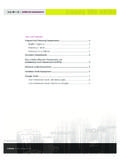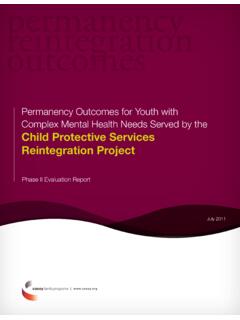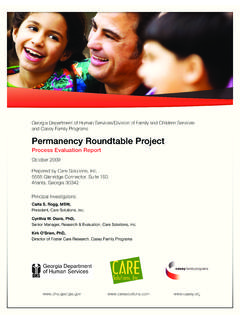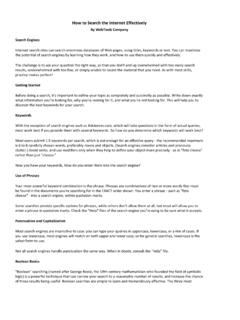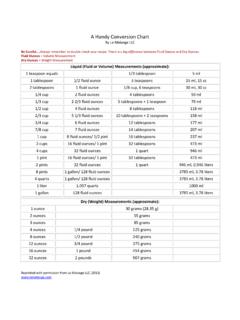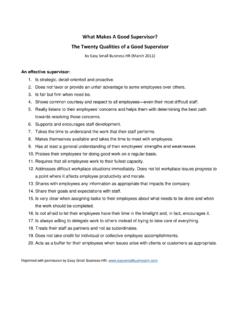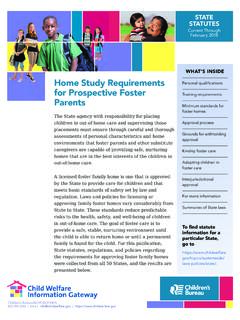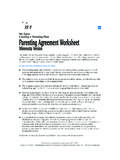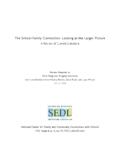Transcription of Maintaining culture and compliance with the Indian Child ...
1 SAFECHILDRENSTRONGFAMILIESSUPPORTIVECOMM UNITIESSAFECHILDRENSTRONG. FAMILIESSUPPORTIVECOMMUNITIESSAFECHILDRE NSTRONGFAMILIESSUPPORTIVE. COMMUNITIESSAFECHILDRENSTRONGFAMILIESSUP PORTIVECOMMUNITIESSAFECHILDREN. STRONGFAMILIESSUPPORTIVECOMMUNITIESSAFEC HILDRENSTRONGFAMILIESSUPPORTIVE. COMMUNITIESSAFECHILDRENSTRONGFAMILIESSUP PORTIVECOMMUNITIESSAFECHILDREN. STRONGFAMILIESSUPPORTIVECOMMUNITIESSAFEC HILDRENSTRONGFAMILIESSUPPORTIVE. SAFECHILDRENSTRONGFAMILIESSUPPORTIVECOMM UNITIESSAFECHILDRENSTRONGFAMILIES. SUPPORTIVECOMMUNITIESSAFECHILDRENSTRONGF AMILIESSUPPORTIVECOMMUNITIES. Strategies for Successfully Recruiting and Retaining Preferred- Placement Foster Homes for American Indian children Maintaining culture and compliance with the Indian Child Welfare Act MARCH 2017.
2 FOSTER PARENT. RECRUITMENT. The authors would like to thank our colleagues for their expert review of this report: Denise Goodman, Kathy Deserly, and Robin Leake. ACKNOWLEDGEMENTS. casey family programs | This brief highlights strategies used by tribal and state teams working to increase the number of foster parents for American Indian children strategies to increase foster placements that reflect children 's culture and comply with the Indian Child Welfare Act (ICWA). Because many Child welfare jurisdictions across the United States face shortages of foster parents , strategies that increase foster care placements in family settings within children 's own communities when foster care is needed may be of broad interest. Note on terminology: America's indigenous population refer to themselves in many different ways.
3 In this document, the authors use the term American Indian to refer to American Indian and Alaska Native individuals and families. The Indian Child Welfare Act uses the term Indian to refer to American Indian and Alaska Native individuals and families. Report prepared by: Lydia Killos, Nancy Lucero, Megan Kauffmann, Misty J. Brammer, Sheri Freemont, and Erin Maher. FOSTER PARENT RECRUITMENT. Strategies for Successfully Recruiting and Retaining ICWA-Preferred Placement Foster Homes for American Indian children Introduction The Indian Child Welfare Act (ICWA) is a comprehensive federal law passed in 1978 that is designed to protect American Indian children , families, and tribes from unnecessary Child removal and displacement. ICWA requires additional responsibilities for the public Child welfare system and special judicial oversight when American Indian children are involved in state Child welfare systems.
4 For example, ICWA requires that, when American Indian children need to be placed in out-of-home care, they are placed with extended family and, whenever possible, in homes that reflect American Indian culture . ICWA has been labeled the gold standard in Child welfare practice by a coalition of 18 national Child advocacy Under ICWA, the intent of Congress is to protect the best interests of American Indian children and to promote the stability and security of tribes and families. Since it was enacted, however, state and federal courts have interpreted ICWA differently, and compliance with ICWA has been As a result, the Bureau of Indian Affairs recently released new binding regulations to assist with ICWA compliance , which became effective in December According to ICWA, American Indian children must be placed in the least restrictive foster care setting that most approximates a family and is most appropriate to the needs of the Child .
5 Child placement must be in reasonable proximity to the Child 's permanent home, the tribe must receive notice, and the tribe may assert its own customary definition of family or extended family. ICWA federal law defines extended family as a person defined by law or tribal custom as family. The definition is not limited to tribal citizens or Indian individuals. The tribe may adopt its own preferences, which supersede the preferences in the statute, and the preferences of the tribe must be used by state courts. Where appropriate, the preference of the Indian Child or parent must also be considered. The tribe may adopt its own preferences, which supersede the preferences in the statute, and the preferences of the tribe must be used by state courts.
6 When foster care is needed, American Indian children should be placed in sequence of the following ICWA preferences: 1. A member of the Child 's extended family. 2. A foster home licensed, approved, or specified by the Indian Child 's tribe. 3. An Indian foster home licensed or approved by an authorized non- Indian agency. 4. An institution for children approved by an Indian tribe or operated by an Indian organization that has a program suitable to meet the Child 's needs. 4. SAFECHILDRENSTRONGFAMILIESSUPPORTIVECOMM UNITIESSAFECHILDRENSTRONGFAMILIES. SUPPORTIVECOMMUNITIESSAFECHILDRENSTRONGF AMILIESSUPPORTIVECOMMUNITIESSAFE. CHILDRENSTRONGFAMILIESSUPPORTIVECOMMUNIT IESSAFECHILDRENSTRONGFAMILIES. FOSTER PARENT RECRUITMENT. In order for a placement to be considered an American Indian foster home, at least one of the foster parents must be a member of a federally recognized tribe.
7 Only upon a finding of good cause may a state court order a placement that does not follow these ICWA provides similar preferences for adoptive homes. The importance of recruiting and retaining ICWA-preferred placements When state courts order the placement of American Indian children in non-preferred placement homes, a frequently cited reason for not following ICWA placement preferences is the lack of available preferred placement homes, which has implications for adoption as American Indian children 's loss of familial, tribal, and cultural connections is likely to increase when they are placed with families who do not share their culture and heritage. The promise of ICWA and its associated impact on American Indian children 's well-being cannot be realized if there are not enough ICWA-preferred placement homes.
8 H I S T O RY O F A M E R I C A N I N D I A N C H I L D R E M O VA L S A N D T R A U M A. Beginning in the late 1800s and continuing into the mid-20th century, many American Indian children were forcibly removed from their parents and communities and enrolled in militaristic, government-run boarding schools, where they were often subject to deprivation and These boarding schools were intended to assimilate American Indian children into the mainstream society by severing their connections to their tribal communities. In addition, many American Indian children were placed in non- Indian foster or adoptive This removal from family, community, and culture is one cause of historical trauma. compliance with ICWA can be part of a trauma-informed approach to Child protective services that includes an awareness of (a) historical group traumatic events, such as forced relocation of family or tribe and American Indian boarding school attendance; (b) intergenerational transmission of trauma; and (c).
9 Individual contemporary trauma ,8. Today, a growing number of Child welfare leaders and policymakers understand the importance of preserving and protecting the rights and culture of American Indians, but efforts are still necessary to increase this understanding. The historical and contemporary lack of state recognition for tribal sovereignty in addressing the needs of tribal children and families sets a tone ripe for conflict and tribal distrust. compliance with ICWA can be part of a trauma-informed approach to Child protective services 5. SAFECHILDRENSTRONGFAMILIESSUPPORTIVECOMM UNITIESSAFECHILDRENSTRONGFAMILIES. SUPPORTIVECOMMUNITIESSAFECHILDRENSTRONGF AMILIESSUPPORTIVECOMMUNITIESSAFE. CHILDRENSTRONGFAMILIESSUPPORTIVECOMMUNIT IESSAFECHILDRENSTRONGFAMILIES.
10 Strategies for Successfully Recruiting and Retaining ICWA-Preferred Placement Foster Homes for American Indian children Project to promote recruitment and retention of ICWA-preferred foster care parents Both state and tribal Child welfare systems struggle to find and retain an adequate number of available foster parents for the increasing number of children and adolescents who need safe, stable, and loving ,10 This challenge is particularly acute for American Indian children who are placed in foster care and whose familial and cultural ties are a central part of their overall To address this need, Casey Family Programs embarked on a project to bring together tribal and state Child welfare teams to collaboratively develop strategies to increase the recruitment and retention of ICWA-preferred foster placements for American Indian children .

